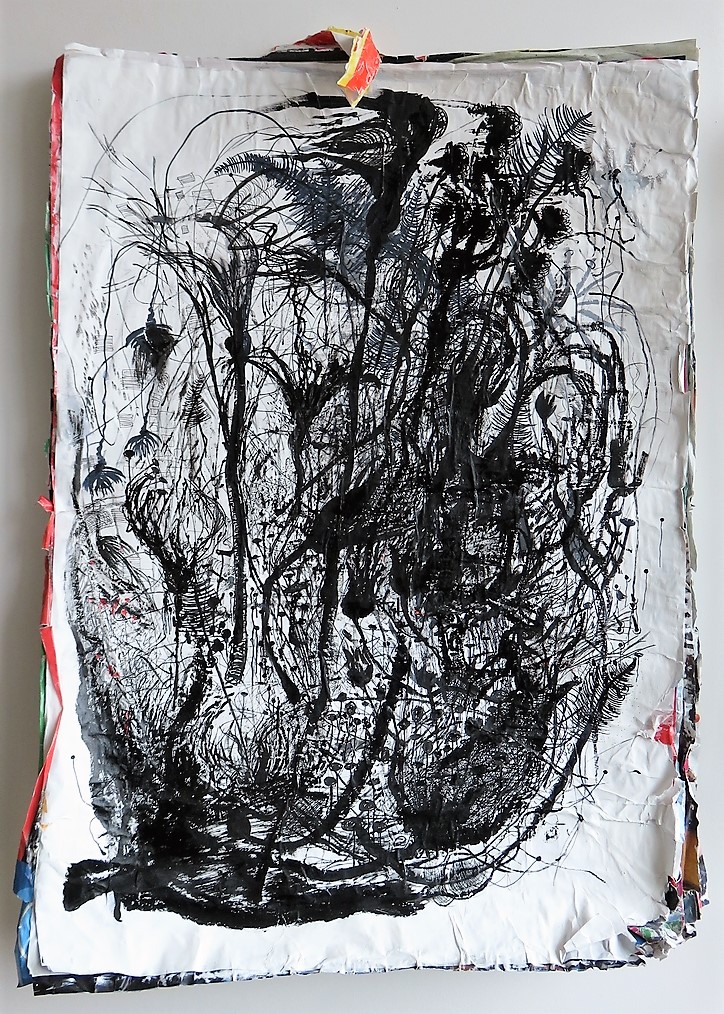 |
 |
MÁXIMO GONZÀLEZ
(b. 1971 in Argentina. Lives and works in Alicante, Spain and Mexico City, Mexico.)
Argentinian artist Máximo González is widely known for his massive immersive mixed-media installations, as well as large-scale collages made out of money. The currency collages, reminiscence of the political wall paintings of the Mexican muralists, express the complications of a consumer culture that exploits natural resources, produces waste, and lately drives nations to bankruptcy. González’s work – often poetic, always political – focuses on the environment, education, and the evolution of cultural value systems.
Máximo González is also the founder of “Changarrito Project”, a non-profit cultural initiative he launched in 2004 in Mexico City. What began as an underground subversive project has evolved into a platform to promote, support and show the work of visual artists, novelists, poets, curators, designers, performers, filmmakers, which has so far has exhibited more than 5,000 works by more than 350 emerging artists. Changarrito was invited twice to participate at Mexico Pavilion in the Venice Biennale (2011 and 2013), and has, since 2012 been operating in cooperation with Mexic-Arte Museum (Texas, USA).
González has held 46 solo shows and participated in 168 group shows. Selected solo exhibitions include: ‘POGO’ at Hospicio Cabañas Museum, Guadalajara (MX); Magnificent Warning at Stanlee & Rubin Center, El Paso (USA); Playful, CAFAM, Los Angeles (USA); ‘Walk among Worlds’ at Casa de América, Madrid (ES) y Fowler Museum, Los Angeles (USA), ‘Something like an answer to something’, Artane gallery, Istanbul (TUR); ‘Project for the reutilization of obsolete vehicles’ at Travesía Cuatro Gallery, Madrid (ES) and Project B, Milano (IT); ‘PISAR’ at Ruth Benzacar, Buenos Aires (ARG); ‘Greenhouse effect’ at Art&Idea, Mexico City.
Selected group shows include: ‘The Supermarket of Images’ at Jeu de Paume in Paris and at Red Brick Art Museum in Beijing, China; ‘Memoria del porvenir’, MUSAC collection (Museo de Arte Contemporáneo de Castilla y León), Spain; Viva México! at Zacheta National Gallery of Art in Warsaw and at BWA Awangarda Gallery, Wroclaw, Poland; ‘The possibility of everything’ at Nuit Blanche Toronto (CA); ‘Where have all the flowers gone?’, Poetics of the handmade exhibition at MOCA LA (USA); ‘The tree: from the sublime to the social’ at the Vancouver Art Gallery (CA); ‘Fine Line’ at Museo de Las Americas in Denver (USA); The lines of the hand at MUAC, Mexico City; ‘2nd Polygraphic Triennial of San Juan’, Latin America and the Caribbean, Puerto Rico; ‘Mexico: Poetry/Politics’, San Francisco State University (USA) and at Nordic Watercolor Museum, Gothenburg (SE); ‘Tiempo de Sospecha’, Museum of Modern Art, Mexico City.
Untitled (‘Tissue Culture’ Animation #1) and N8 – Carbonic Incineration 1 form part of a large body of work resulting from Máximo González’s 3-month Artist Residency at MOMENTUM AiR in 2021.
UNTITLED (‘TISSUE CULTURE’ ANIMATION #1)
2021, Video Animation, 2 min 25 sec
Marching through the shelf of a library, some decorative objects and other toys, peek into a drawing that absorbs them in a universe of colorless lines, where an indecipherable shape squeezes them to make room for those who continue to arrive. The drawing gradually becomes denser, until at a certain moment it begins to be imperceptibly released: the elements that had entered leave the drawing and, little by little, it becomes a simpler composition, without saturation.
– Artist Statement by Iván Buenader
N8 – CARBONIC INCINERATION 1
2021, Tissue culture oil, ink, acrylic and gesso on pasted street signs, 85 x 60 x 5 cm

On the streets of the city of Berlin, street posters are piled up on the walls, one on top of the other, glued together with paste. Some promote a new hamburger, others a musical concert, a home delivery app or an express covid test service. The stacking of posters creates a volume that, with the passing of days, is destined to disappear: a downpour falls on the city and they become so heavy that they bend like a withered flower, or someone tears them off as a souvenir or innocuous form of vandalism, or the city council removes them when it performs its regular cleaning.

In her laboratory, a Polish scientist, under a microscope, places a number of cells on a substance that is used for their proliferation. Cells will begin to reproduce slowly, then quickly, until they meet their limit and begin to shrink. It is difficult to distinguish when or what the maximum point was before beginning their decrease, in search of their own balance.
Hanging on the wall, on the whitened surface of a pile of posters, there is an unclassifiable, carbonic-looking shape that expands on the paper as if it were burning, or perhaps it contracts, as if it were submerging.
– Artist Statement by Iván Buenader


 Back to Index
Back to Index